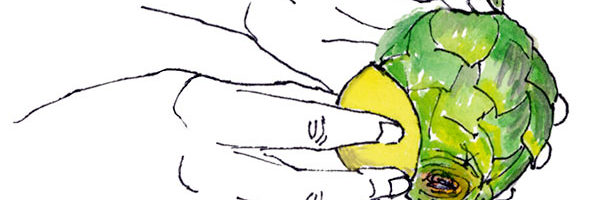
Play Ball!
Navigating Little League without the gluten
Ahhh, spring! The time of year when the ground thaws, the trees begin to bud, the grass begins to green, we plant our garden, and lament over our pasty white winter skin tone. Growing up in Ohio, I always looked forward to spring after the long dreadful winter. While my reasons for doing so have changed over the years, I still always enjoy this season.
My husband looks forward to spring for different reasons (he’s never really had a problem being pasty white). At some point in early February, I will hear these words from my husband as though they were uttered by a child waiting for Christmas morning: “You know, pitchers and catchers report to training camp next week.”
Like that’s supposed to mean anything to me? If I make the mistake of rolling my eyes or not treating this annual phenomenon as though it were a semi-religious event, he will voluntarily sleep on the couch for a week (not that I mind, it’s nice to have the whole bed to yourself sometimes). I mean, he hears a certain introduction jingle on Sports Center this time of year (apparently there is a different one for each sport) and he nearly wets his pants because the baseball electrode in his brain goes into hyper drive.
Yes, I’m referring to the beginning of the uniquely American pastime known as baseball season, or as it’s better known in our home, Little League. Oh joy. It’s time for Little League … again.
Don’t get me wrong. I’m glad both of my boys play baseball and I’m glad my husband has coached every team they’ve been on through the years. He now coaches two teams, six days a week, five hours on Saturday. Don’t get me wrong. I’m glad both of my boys play baseball and I’m glad my husband has coached every team they’ve been on through the years. He now coaches two teams, six days a week, five hours on Saturday.
Have you ever sat on a red-hot metal bleacher on a 100 degree day with the wind whipping dirt in your face? For four hours? Watching your six year old pick dandelions in the outfield and draw in the dirt? Yes, it’s cute, but he can do those things in my backyard while I remain frosty cold in the living room. My husband tells me that this rite of passage can only be experienced on a baseball field, that it builds character in the boys, and that my sitting on the bleachers is all “part of the experience.” I suppose that crusty white ring of dried sweat circling his baseball cap is all part of the experience as well. (He won’t let me wash it. It’s some bizarre superstition like not changing your socks on a win streak.)
When you sign up for Little League, you have to do everything in your power to avoid becoming the “Team Mom.” You get nothing as Team Mom. You don’t get a trophy, you don’t get to be in the team picture, you have to be at every game, organize the end-of-year picnic, find another parent to work the snack bar, and work the dugout when there aren’t enough dads around. But by far the most important function of the Team Mom is to organize the snack schedule. God help you if those little tykes don’t get their snack after the game. I think that’s the only reason some of those boys even show up.
I’ve seen this play out many times. As soon as the designated snack person shows up with a couple of grocery bags, the boys immediately start poking around to see if it’s a good snack or a bad snack (from their point of view). Of course, “good” snacks are loaded with some form of sugar, devoid of any substantial nutritional value, only slightly resemble actual food, and are certain to put the children into a mini-coma within an hour or so.
“Bad” snacks are usually a whole fruit or nuts (or both), 100% natural juice, or – heaven forbid – actual water! I remember when I was growing up our snack was orange wedges with water. Do you remember that? And that was if we even had a snack at all.
I’m not sure when having a snack after the game became part of the deal. Probably about the same time we decided that everyone should get a trophy regardless of what place they take. But like so many other events in modern life, food has wiggled its way into our youth sports and I don’t think it’s going away anytime soon. So you’re going to have to learn to cope the way we did.
For starters, there is likely another kid on the team with a food allergy. I think there have only been a couple of times where this was not the case for us, so you probably already have a parent ally in the stands. It’s usually a peanut allergy, but this allergy-fighting mom will help other moms understand how important it is to at least try … so find her fast and make friends!
The next step is to ask the Team Mom to make a note on the snack schedule to try not to bring snacks that contain gluten, which is found in wheat, barley, rye, and commercial oats. This could be a little tricky, because it may seem like you’re really handcuffing snack time by eliminating so many ingredients, even though you’re only eliminating one. Help the Team Mom understand that you know it may be hard for the other parents to comply, so you’re just asking them to try their best. I know this is not ideal, but ideal situations walked out the door the day we were diagnosed. At the end of the day, there will be games when your child politely takes the bag of crackers that then conveniently finds its way into a garbage can. (If your child is old enough to play ball, they probably know by now not to eat anything until you check it.) If you have to hover at the dugout entrance to snatch it away, so be it.
Speaking of ideal situations, I’ve learned that the best thing you can try to do is change the whole tone of snack time in the first place. Leading by example is usually the most influential method, so roll up your sleeves and get in there! When you’re talking with the Team Mom, go ahead and volunteer to bring snacks for the very first game (or two). Instead of bringing chocolate donuts from the grocery store bakery, you’re going to bring three bunches of bananas (or do the old-fashioned orange wedges) and 100% juice boxes. Again, water is ideal, but six-year-olds may balk at that, which kind of defeats the whole purpose.
Most parents will appreciate the fact that you brought a healthy snack. Now you have set the bar, so to speak. The key is to be sure you don’t bring one healthy snack (fruit) and one unhealthy snack (gluten-free gummy bears). The kids will take the unhealthy snack and you will take nine bananas home. They can either be healthy or hungry!
After that you just have to use your bleacher time to subtly insert your child’s celiac disease/gluten intolerance/food allergy into as many positive conversations as you can, where appropriate. You have to pick your moments, but a lot of times other moms will bring it up for you. And frankly, if they give you an inch then go ahead and take a mile, but don’t go overboard. Just try to talk about making whole foods, how many alternatives are now available, and how it’s really not that hard with a little preparation. Remember, you are planting seeds at this point that will hopefully sprout into healthy (or at least gluten-free) baseball snacks.
In the end, it’s about the game and not the snack. It’s really no different than navigating a birthday party. You just have to do it in the heat and dust and wind four days a week – hey, I live in the desert, people – after you’ve soaked the white uniform pants in bleach for six hours and helped your husband find his coach’s jersey (try the dirty clothes hamper, honey … that’s where you left it).
Have a great spring! See you at the field.
Written by Heidi Kelly



